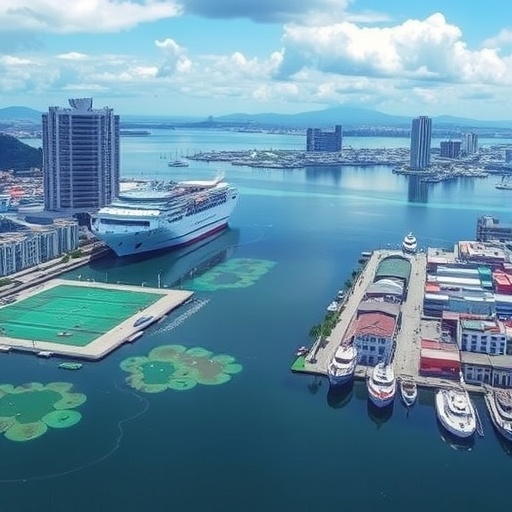In the pursuit of understanding environmental pollution and its impacts, recent research has brought to light pressing concerns regarding heavy metal contamination in Cartagena Bay, nestled in the Colombian Caribbean. As urban and industrial activities burgeon, the surrounding ecosystems are increasingly threatened by the influx of hazardous materials. The study conducted by Cusba, Pacheco, Ibarra-Gutiérrez, and their colleagues provides a profound insight into this critical issue by employing a novel modeling approach to tackle the complexities of censored data. The findings not only highlight the current state of contamination but also advocate for more robust environmental monitoring strategies.
Heavy metals, such as lead, cadmium, and mercury, pose significant risks to both marine life and human health. Their persistence in the environment and bioaccumulation in the food chain amplify concerns, making it essential to accurately assess their levels and sources. The research team employed a holistic assessment methodology, integrating various data sources and modeling techniques to present a clearer picture of the contamination landscape in Cartagena Bay. By focusing on censored data, which often skews the true nature of environmental assessments, the researchers aimed to elucidate the extent of contamination in waters that are vital to the local fishing communities.
Central to the study’s methodology was the use of advanced statistical models that account for the missing or non-detectable data points typical in environmental studies. Conventional assessment methods can fall short in scenarios where concentrations are below detection limits, often leading to underestimation of actual contamination levels. By employing techniques to effectively model this censored data, the researchers were able to provide a more comprehensive evaluation of heavy metal presence in the bay, potentially setting a new standard for future environmental assessments.
The results of the study are alarming, revealing significantly elevated levels of heavy metals throughout Cartagena Bay. These findings are compounded by the region’s socio-economic dynamics, where fishing and tourism are critical components of the local economy. High levels of contamination could threaten the livelihoods of those who depend on clean and healthy marine resources. The implications of these findings reach far beyond the environment, touching on social justice issues as marginalized communities often bear the brunt of pollution without adequate resources to combat its effects.
Beyond merely outlining the contaminant levels, the research proposes actionable recommendations aimed at mitigating the pollution crisis in Cartagena Bay. An emphasis on enhanced regulatory frameworks and stricter enforcement of waste management practices is critical. These policies should not only aim to reduce discharges into the bay but also promote sustainable practices that protect the marine ecosystem. Collaborative efforts involving government agencies, non-governmental organizations, and local stakeholders will be paramount in driving the changes needed to restore the health of this vital waterway.
Furthermore, the study highlights the need for ongoing monitoring and research to track changes in contamination levels over time. As environmental conditions, economic activities, and policy frameworks evolve, continuous evaluation will be essential to ensure that interventions remain effective and relevant. Establishing long-term monitoring programs will not only aid in assessing the success of mitigation strategies but also help in raising public awareness about the importance of protecting marine environments.
The integration of community-based approaches to environmental management can also play a pivotal role in addressing contamination issues. Engaging local populations in monitoring efforts not only empowers them but also fosters a sense of stewardship towards the environment. Education programs focusing on environmental conservation and the significance of maintaining clean waters can galvanize community action and promote more responsible behavior towards the use of marine resources.
Importantly, the findings from this research can serve as a template for addressing heavy metal contamination in other coastal areas facing similar challenges. The methodological framework established by Cusba and her colleagues could be adapted and employed in various contexts globally, contributing to a broader understanding of pollution dynamics and the efficacy of different intervention strategies. This cross-application of research findings can enhance global efforts to combat marine pollution and safeguard public health.
In conclusion, the urgency of addressing heavy metal contamination in Cartagena Bay cannot be overstated. The meticulous research conducted by Cusba et al. sheds light on the complex interplay between environmental pollution and local communities’ health and livelihoods. Their innovative approach to modeling censored data stands as a significant contribution to the field of environmental monitoring, setting a precedent for future studies. As we look towards the future, collaborative action, informed by robust research, will be essential in restoring and protecting our precious marine ecosystems.
This pivotal study not only calls for immediate attention to pollution in Cartagena Bay but also serves as a rallying cry for scientists, policymakers, and communities worldwide to prioritize environmental health and sustainability. The path ahead may be challenging, yet it is paved with opportunity for innovation and impactful change.
Subject of Research: Heavy metal contamination in Cartagena Bay, Colombia.
Article Title: Modeling censored data for a holistic assessment of heavy metal contamination in Cartagena Bay, Colombian Caribbean.
Article References:
Cusba, J., Pacheco, C., Ibarra-Gutiérrez, K. et al. Modeling censored data for a holistic assessment of heavy metal contamination in Cartagena Bay, Colombian Caribbean.
Environ Monit Assess 197, 1335 (2025). https://doi.org/10.1007/s10661-025-14664-5
Image Credits: AI Generated
DOI: https://doi.org/10.1007/s10661-025-14664-5
Keywords: Heavy metal contamination, Cartagena Bay, environmental monitoring, censored data modeling, marine pollution, public health, ecological assessment.




